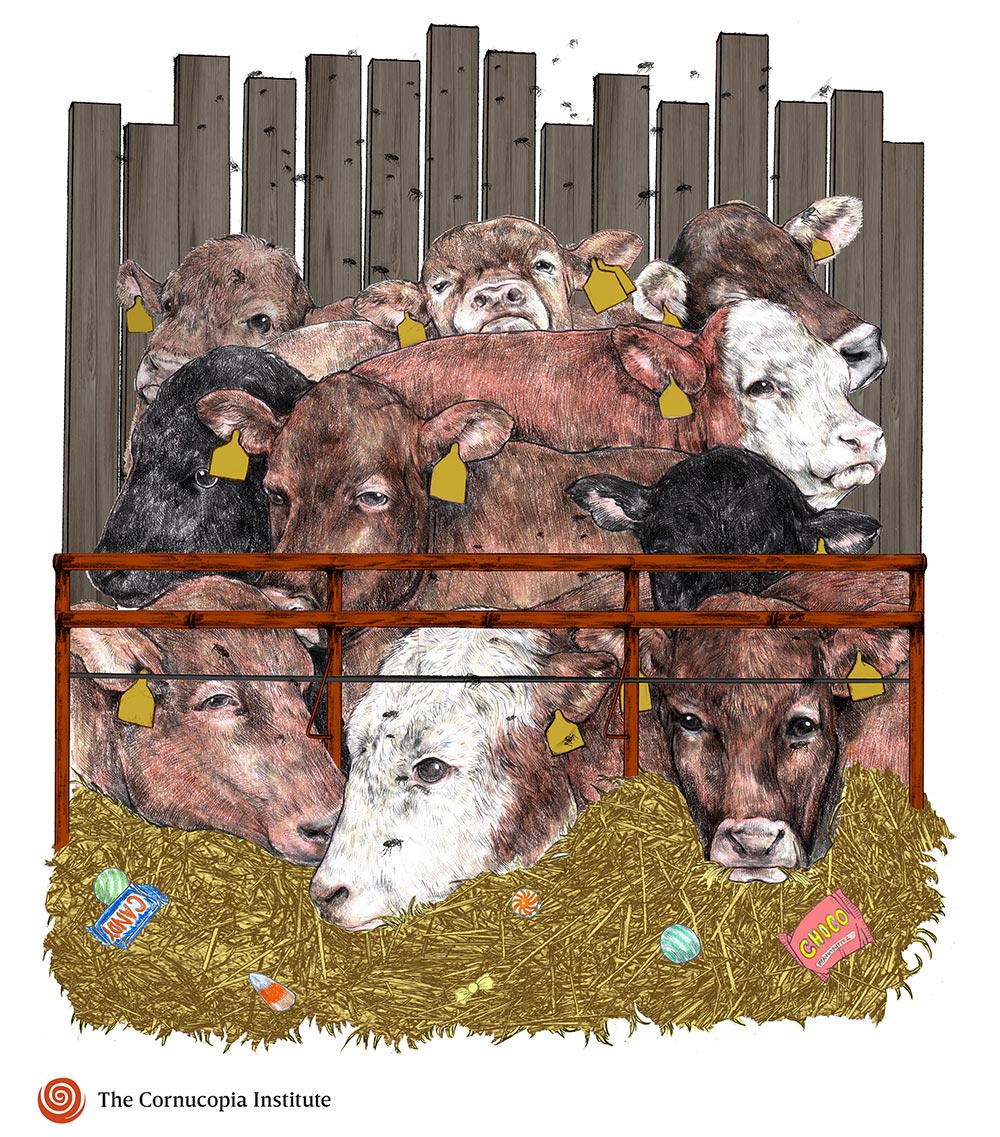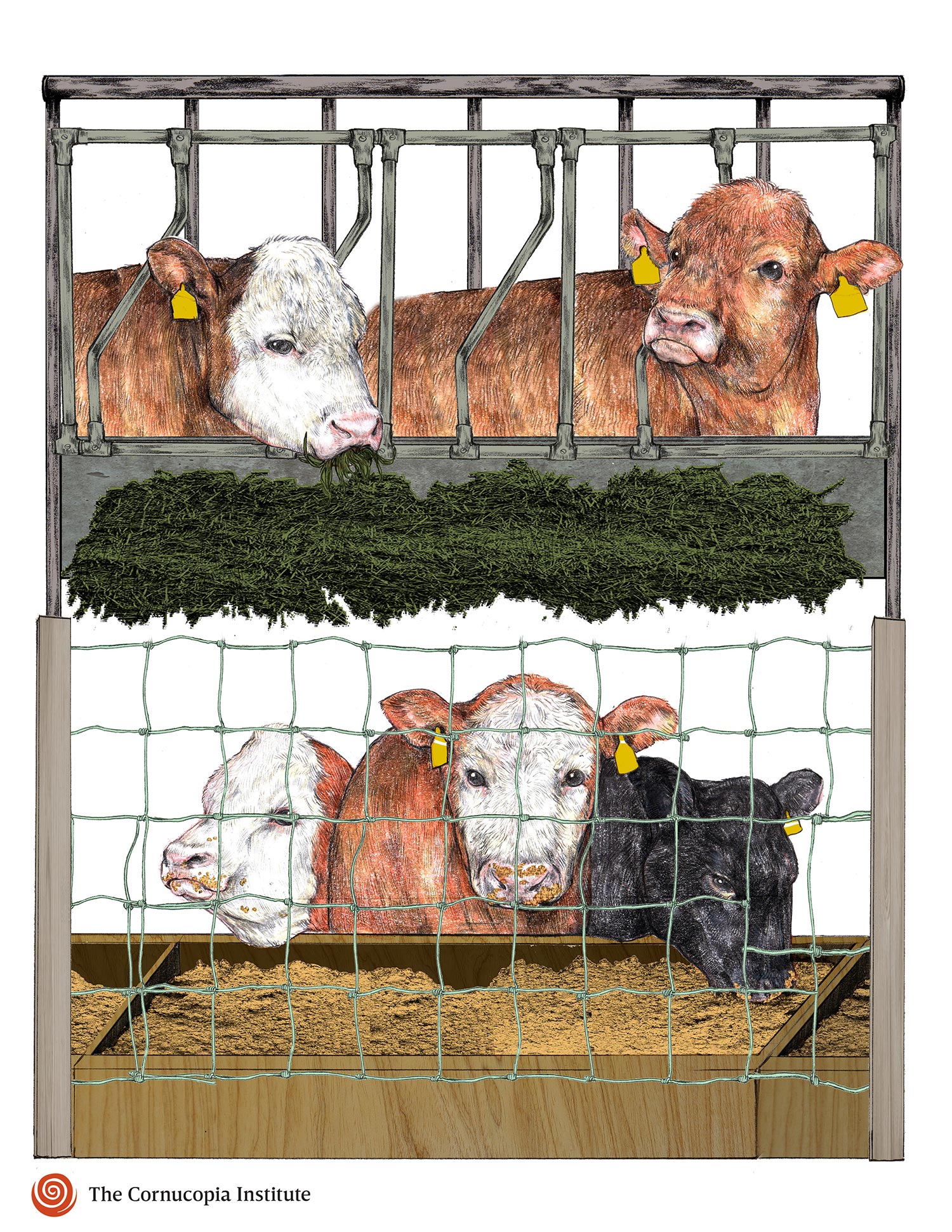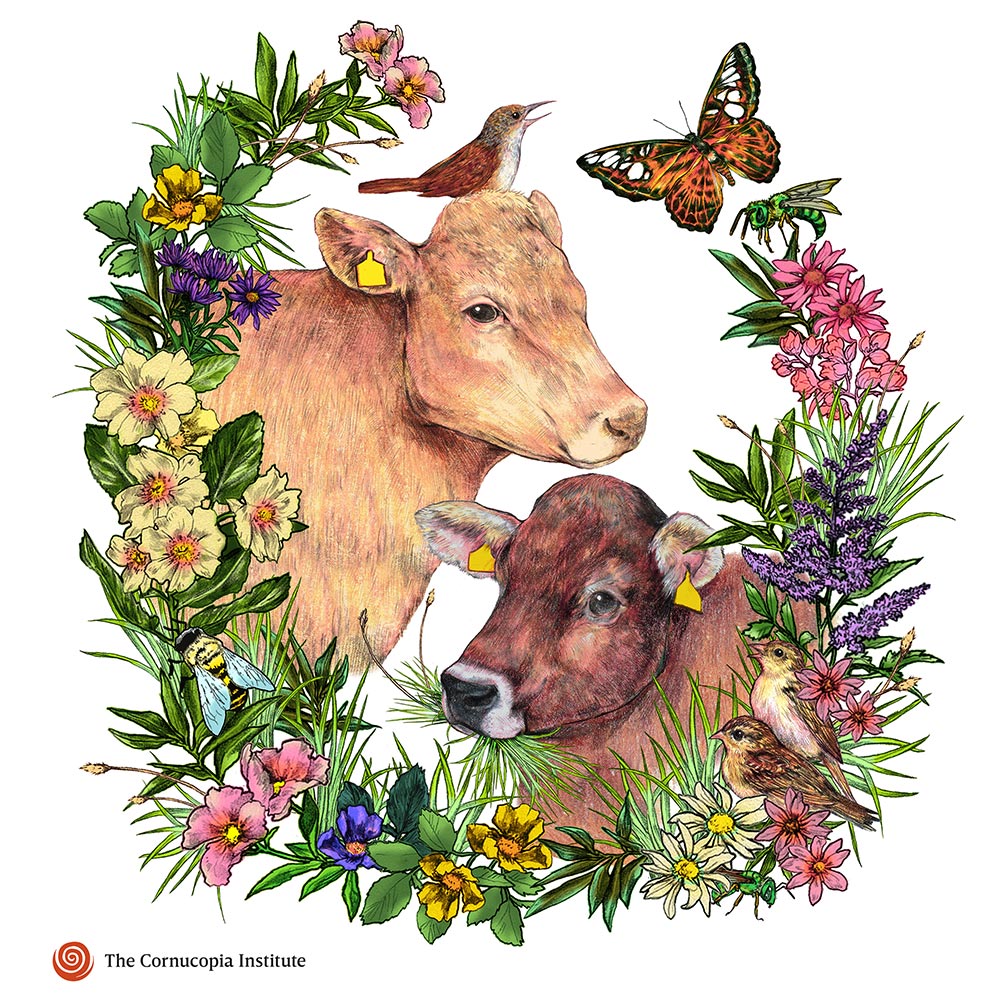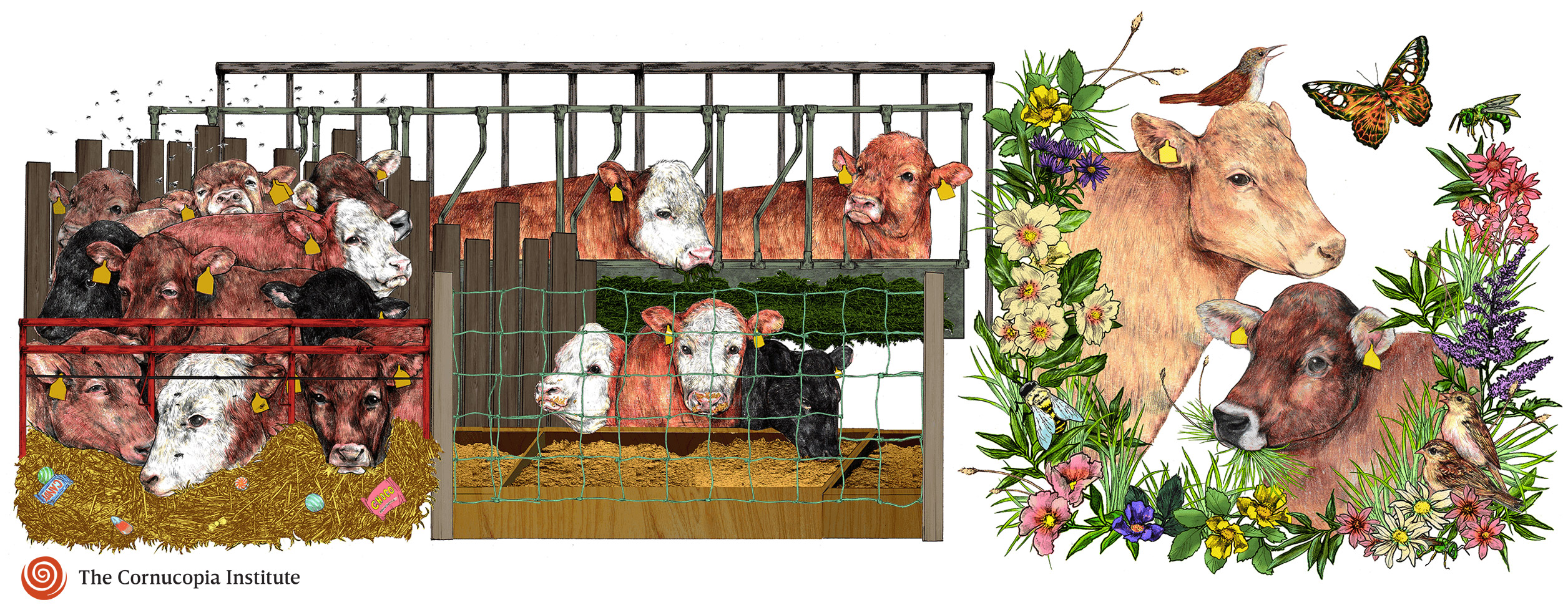Not all cattle are raised the same. There are substantial differences between conventional and authentic organic beef production when it comes to environmental impact, animal welfare, and nutrition. And due to eroding certification standards, the organic program allows a wide range of production practices. Lack of transparency in the industry, alongside complicated, obscure, and often misleading labeling, makes it difficult for consumers to really know what’s going on behind the scenes and to make purchasing decisions that support their health and protect the environment. (Our Organic Beef Scorecard, an in-depth rating of organic certified beef across the country, helps you support authentic organic beef producers.)
We commissioned the illustrations on this page from artist Fumi Mini Nakamura. Read the story behind her art below.
Factory Farm

Land and water use: Environmental impact is severe; even if less land is used per pound of beef produced than pasture-based systems, this does not take into account the land damaged from conventional feed production. Manure lagoons that store waste from feedlots often leak, polluting waterways and drinking water.
Feed: Conventional “factory-farmed” cattle are fed diets emphasizing cereal grains and soy, all of which are heavily sprayed and often derived from genetically modified crops. In conventional feedlots, cattle are fed rubbish or leftovers from other industries.
Animal Welfare: Cattle live in close contact with their manure and pests, and they are often given low levels of antibiotics to prevent the inevitable diseases that arise in crowded, stressful situations where they are eating an unnatural diet.
Ecological impacts: Severe global and local environmental impacts, including waterway pollution causing ecological damage and pollution of human drinking water. Factory farmed cattle are major contributors to climate change.
Human Health: Antibiotic and hormone use leads to antibiotic resistant pathogens and potential hormonal impact. Nutritive benefits of factory farmed beef are lower because they do not feed on fresh forage during finishing.
Industrial Organic

Land and water use: Cattle are required to graze on pasture during the grazing season, even during finishing. However, industrial organic beef cattle are typically finished on feedlots.
Feed: All feed must be certified organic (meaning it is non-GMO and free of harmful chemicals), but organic cattle can be finished on grain and other concentrated feed. The use of cheap, imported organic feed carries a high risk of organic fraud.
Animal Welfare: Animal welfare is improved because the use of hormones and routine use of antibiotics are not allowed under the organic label. If cattle are truly ill, organic rules require treatment with necessary pharmaceuticals to prevent suffering (but that animal can no longer be sold as organic).
Ecological impacts: Vary widely. With many animals crowded into the feedlot for finishing, manure overloads the soil, pollutes the air, and runs off into waterways. Still, the use of organic feed is superior to the chemical-intensive feed used in conventional operations.
Human Health: All organic beef is free from harmful chemical inputs, making it safer to eat. Nutrients in beef vary widely depending on the quality of the animals’ diet (fresh forage improves the nutrient density of beef).
Authentic Organic

Land and water use: Managed in a way that sequesters carbon in the soil and conserves biodiversity by encouraging native species. Water pollution is prevented by avoiding erosion and manure overload.
Feed: 100% organic feed that is always non-GMO and free from synthetic fertilizers and toxic pesticides, typically grown on-farm or nearby. Authentic organic beef can also be 100% grass-fed.
Animal Welfare: Animal welfare is higher because cattle are given more natural diets, are able to socialize within their herd, and typically live healthier, longer lives.
Ecological impacts: Authentic organic ranchers and cattle farmers often use regenerative practices that mitigate some of the harms cattle can perpetuate. The land and livestock are managed in such a way to have them work in concert, not in opposition.
Human Health: Authentic organic, especially 100% grass-fed organic beef, is higher in vitamins A and E, conjugated linoleic acid, and other nutrients. Eaters may notice a difference in how this beef tastes and looks compared to beef raised in industrial production.
The Story Behind the Art

Food has always been an important part of my life. I grew up in central Japan, close to the mountains and the ocean, in Shimizu City, Shizuoka, which is known for green tea, tangerines, and strawberries.
My grandmother, who lived with us, hosted a local organic food co-op that served our neighbors. I ate a lot of organic food. She was always pickling fruit and leaves and using them as remedies for whatever ailed us. One of my favorite dishes was her winter melon soup, which is similar to turnip soup. What made her soup special was the ginger and chicken broth. It was fantastic.
I’ve always been curious about where my food comes from and read a lot of Modern Farmer articles when that magazine first launched. The labels on food are confusing and it’s hard to know if your money is supporting the right people. So when Cornucopia commissioned me to do this project, I was immediately interested.
I started the process by looking at a lot of images and doing a lot of reading. It was eye opening. The candy fed to cattle in factory farms really surprised me. I remember thinking, no way. But then I saw an interview with a farmer saying how much cheaper it is than eating corn. As I was doing my own food shopping, I started wondering about the meat I was buying at the grocery store. I remember holding a package in my hands for a really long time, wondering what kind of life the animal lived.
Illustrating the authentic organic systems and imagining what each insect and animal is like and how their lives are intertwined was therapeutic, especially because I live in New York City. Connection to the natural world is something we’re all missing.
But the choices we make around our food are often shaped by the lure of convenience. And we often don’t want the total truth. It’s a hard pill to swallow. I hope people can look at these three different systems and use this imagery to be more aware when they shop. I think it’s an important education people should have.
Fumi Mini Nakamura is an artist and illustrator living in Brooklyn. The Cornucopia Institute staff commissioned her illustrations after falling in love with her cover design for World of Wonders: In Praise of Fireflies, Whale Sharks, and Other Astonishments.
Read the rest of our report: Value Meal: The Benefits of Organic Beef Production.


